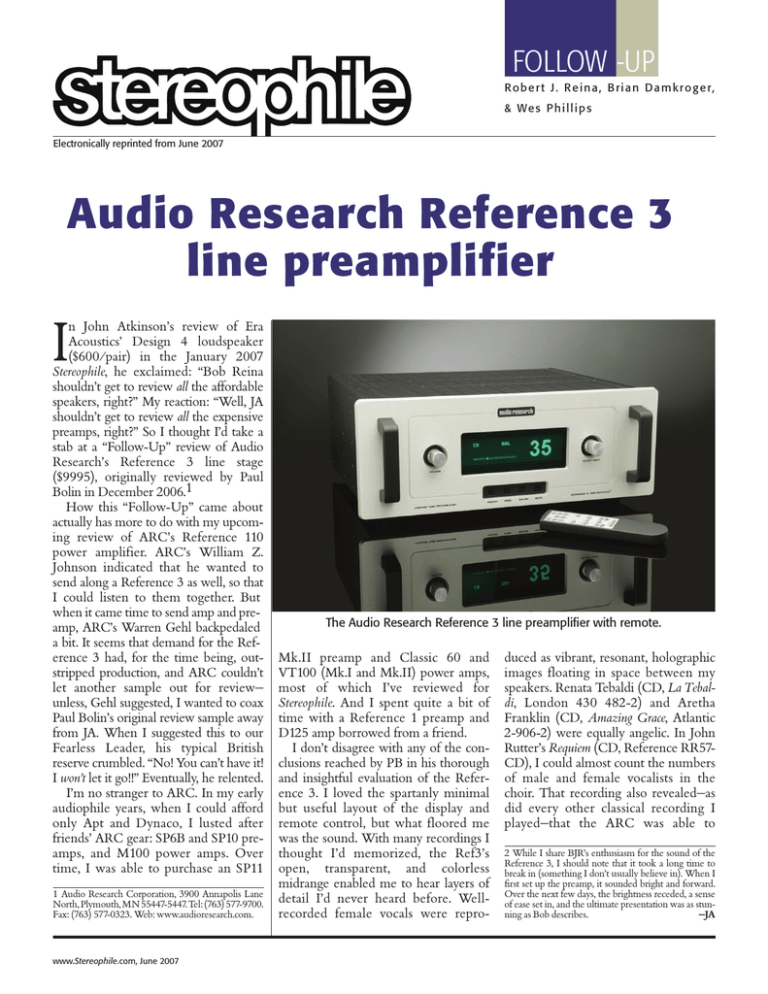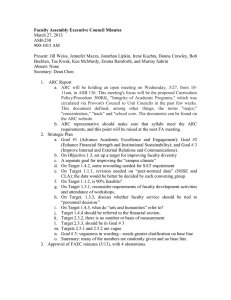
FOLLOW -UP
R o b e r t J . R e i n a , B r i a n D a m k r o g e r,
& We s P h i l l i p s
Electronically reprinted from June 2007
Audio Research Reference 3
line preamplifier
I
n John Atkinson’s review of Era
Acoustics’ Design 4 loudspeaker
($600/pair) in the January 2007
Stereophile, he exclaimed: “Bob Reina
shouldn’t get to review all the affordable
speakers, right?” My reaction: “Well, JA
shouldn’t get to review all the expensive
preamps, right?” So I thought I’d take a
stab at a “Follow-Up” review of Audio
Research’s Reference 3 line stage
($9995), originally reviewed by Paul
Bolin in December 2006.1
How this “Follow-Up” came about
actually has more to do with my upcoming review of ARC’s Reference 110
power amplifier. ARC’s William Z.
Johnson indicated that he wanted to
send along a Reference 3 as well, so that
I could listen to them together. But
when it came time to send amp and preamp, ARC’s Warren Gehl backpedaled
a bit. It seems that demand for the Reference 3 had, for the time being, outstripped production, and ARC couldn’t
let another sample out for review—
unless, Gehl suggested, I wanted to coax
Paul Bolin’s original review sample away
from JA. When I suggested this to our
Fearless Leader, his typical British
reserve crumbled. “No! You can’t have it!
I won’t let it go!!” Eventually, he relented.
I’m no stranger to ARC. In my early
audiophile years, when I could afford
only Apt and Dynaco, I lusted after
friends’ ARC gear: SP6B and SP10 preamps, and M100 power amps. Over
time, I was able to purchase an SP11
1 Audio Research Corporation, 3900 Annapolis Lane
North, Plymouth, MN 55447-5447. Tel: (763) 577-9700.
Fax: (763) 577-0323. Web: www.audioresearch.com.
www.Stereophile.com, June 2007
The Audio Research Reference 3 line preamplifier with remote.
Mk.II preamp and Classic 60 and
VT100 (Mk.I and Mk.II) power amps,
most of which I’ve reviewed for
Stereophile. And I spent quite a bit of
time with a Reference 1 preamp and
D125 amp borrowed from a friend.
I don’t disagree with any of the conclusions reached by PB in his thorough
and insightful evaluation of the Reference 3. I loved the spartanly minimal
but useful layout of the display and
remote control, but what floored me
was the sound. With many recordings I
thought I’d memorized, the Ref3’s
open, transparent, and colorless
midrange enabled me to hear layers of
detail I’d never heard before. Wellrecorded female vocals were repro-
duced as vibrant, resonant, holographic
images floating in space between my
speakers. Renata Tebaldi (CD, La Tebaldi, London 430 482-2) and Aretha
Franklin (CD, Amazing Grace, Atlantic
2-906-2) were equally angelic. In John
Rutter’s Requiem (CD, Reference RR57CD), I could almost count the numbers
of male and female vocalists in the
choir. That recording also revealed—as
did every other classical recording I
played—that the ARC was able to
2 While I share BJR’s enthusiasm for the sound of the
Reference 3, I should note that it took a long time to
break in (something I don’t usually believe in). When I
first set up the preamp, it sounded bright and forward.
Over the next few days, the brightness receded, a sense
of ease set in, and the ultimate presentation was as stunning as Bob describes.
—JA
F O L LO W- U P
unravel an uncanny amount of hall
ambience and room sound. The ARC
showed me that my Alón Circe speakers were capable of much wider, deeper
soundstaging than I’d thought they
were. The resolution of detail was
extraordinary with rock recordings as
well, as I picked apart every instrumental line in George and Giles Martin’s
layered collage rearrangement of the
finale of “Strawberry Fields Forever,”
from the Beatles’ Love (CD, Capitol
09463 79808-2).
Two aspects of the Reference 3’s performance really astounded me. First, its
high-frequency presentation was
unique. Not only were the highs
detailed, extended, and colorless, but
there was a sense of purity and cleanness that I’d never heard from a preamp.
Presumably, this is related to the
extended bandwidth and harmonic-distortion signature JA discussed in the
“Measurements” section that accompanied PB’s review.2 The upper partials of
orchestral woodwinds were pristine and
extended, and ride cymbals in all jazz
recordings were indistinguishable from
those heard live—as were Bill Ware’s
vibes in Sir Duke, his recording of duets
with guitarist Marc Ribot on tunes by
Duke Ellington (CD, Knitting Factory
Works KFW295). Kraftwerk’s Mini-
mum/Maximum (CD, EMI ASW 6061)
revealed subtleties of electronic percussion transients that enabled me, for the
first time, to divine how Ralf Hutter
and Florian Schneider create their
unique electronic waveforms. It wasn’t
necessary to use an audiophile recording to hear the ARC’s high-frequency
strengths: even the anchor on the nightly news seemed to project crystalline
sibilant clarity.
Second, the ARC exhibited a
tremendous sense of ease: no matter
how complex or dense the recording,
the Reference 3 never seemed to be
working hard to reproduce it. The preamp seemed relaxed—but in saying that
I don’t mean to imply that it sounded
soft, muffled, or blurred in any way.
With every recording I tried, transients
were lightning-fast without being
etched. Love Derwinger’s rendition of
the explosive first movement of David
Chesky’s Piano Concerto, with Rossen
Gergov and the Norrlands Opera Symphony Orchestra (Urban Concertos;
SACD, Chesky SACD326, “Red Book”
layer), put the ARC through its paces,
but low- and high-level dynamics were
equally linear and organic, without a
trace of compression.
I found the Ref3’s bass response to be
extended and uncolored. My only quib-
ble was that, compared with some other
preamps I’ve heard, electric basses and
timpani sounded just a touch softer and
less explosive than they should have.
On the Kraftwerk recording, for example, the lowest bass-synth blasts seemed
a touch rounded and could have used a
hint more dynamic slam. But I’m really
splitting hairs here.
I compared the Reference 3 to my
reference line stage, the Audio Valve
Eklipse ($4200). The Eklipse’s
midrange is equally rich, uncolored, and
seductive, but the ARC resolved more
inner detail. Although I feel the Eklipse
is very strong at ambience retrieval and
soundstaging, the ARC bettered it in
almost every respect. And while the
Eklipse had extended and uncolored
high frequencies, the ARC’s lack of
electronic haze made me notice, for the
first time, that the Eklipse sounded a bit
more mechanical and less pure in the
highs. Through both preamps the bass
was extended and neutral, but I felt that
the Eklipse had more dynamic slam,
power, and tautness than the ARC, particularly in the midbass.
The Audio Research Reference 3 is a
stunning achievement that, in many
areas, achieves a level of realism that I
did not think possible from any audio
component.
—Robert J. Reina
3900 Annapolis Lane North / Plymouth, Minnesota 55447-5447 / PHONE: 763-577-5447 FAX: 763-577-0323
Visit us at http://www.audioresearch.com
Posted with permission from the June 2007 issue of Stereophile ® www.stereophile.com. Copyright 2007, PRIMEDIA Inc. All rights reserved.
For more information about reprints from Stereophile, contact Wright’s Reprints at 877-652-5295.
40788



